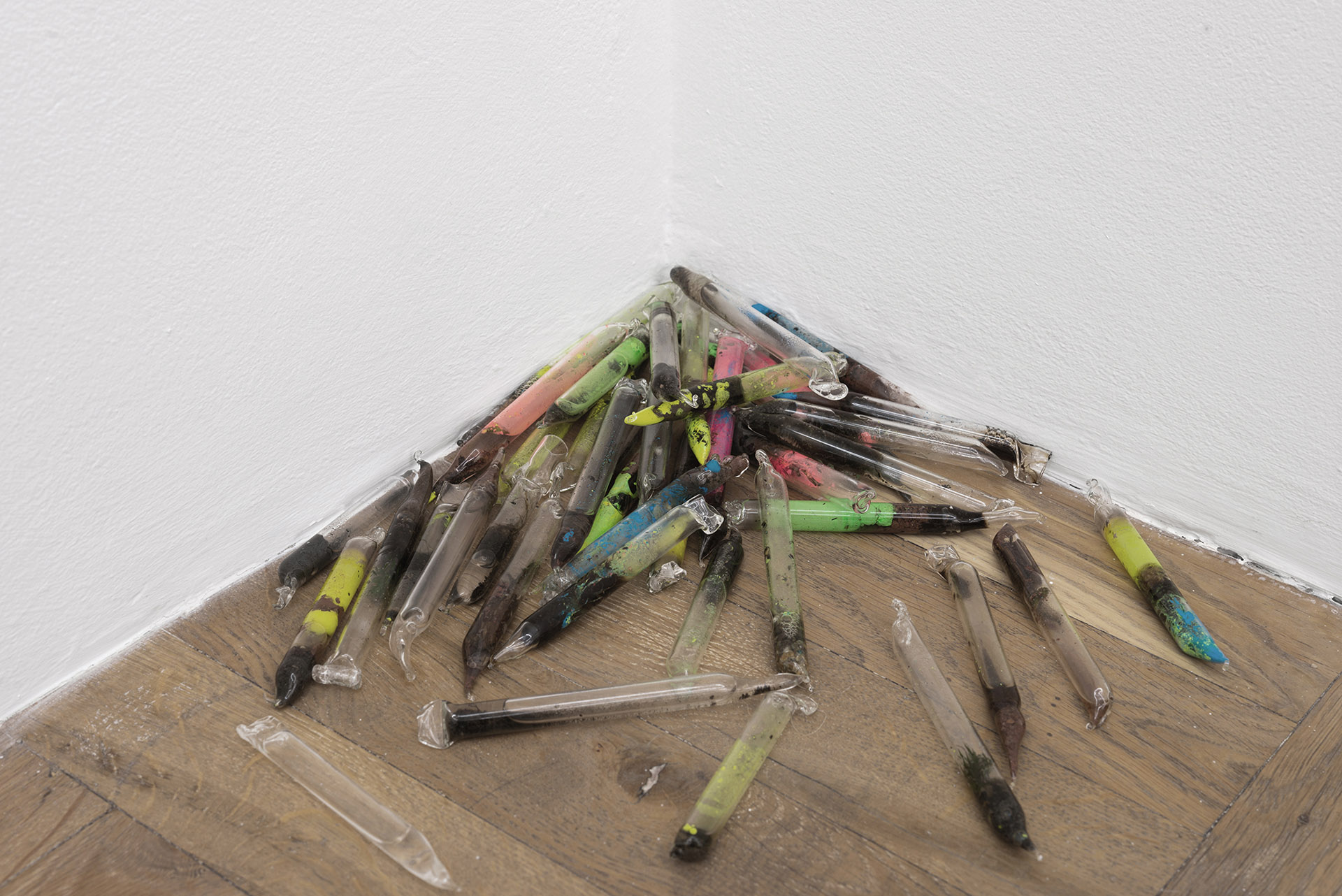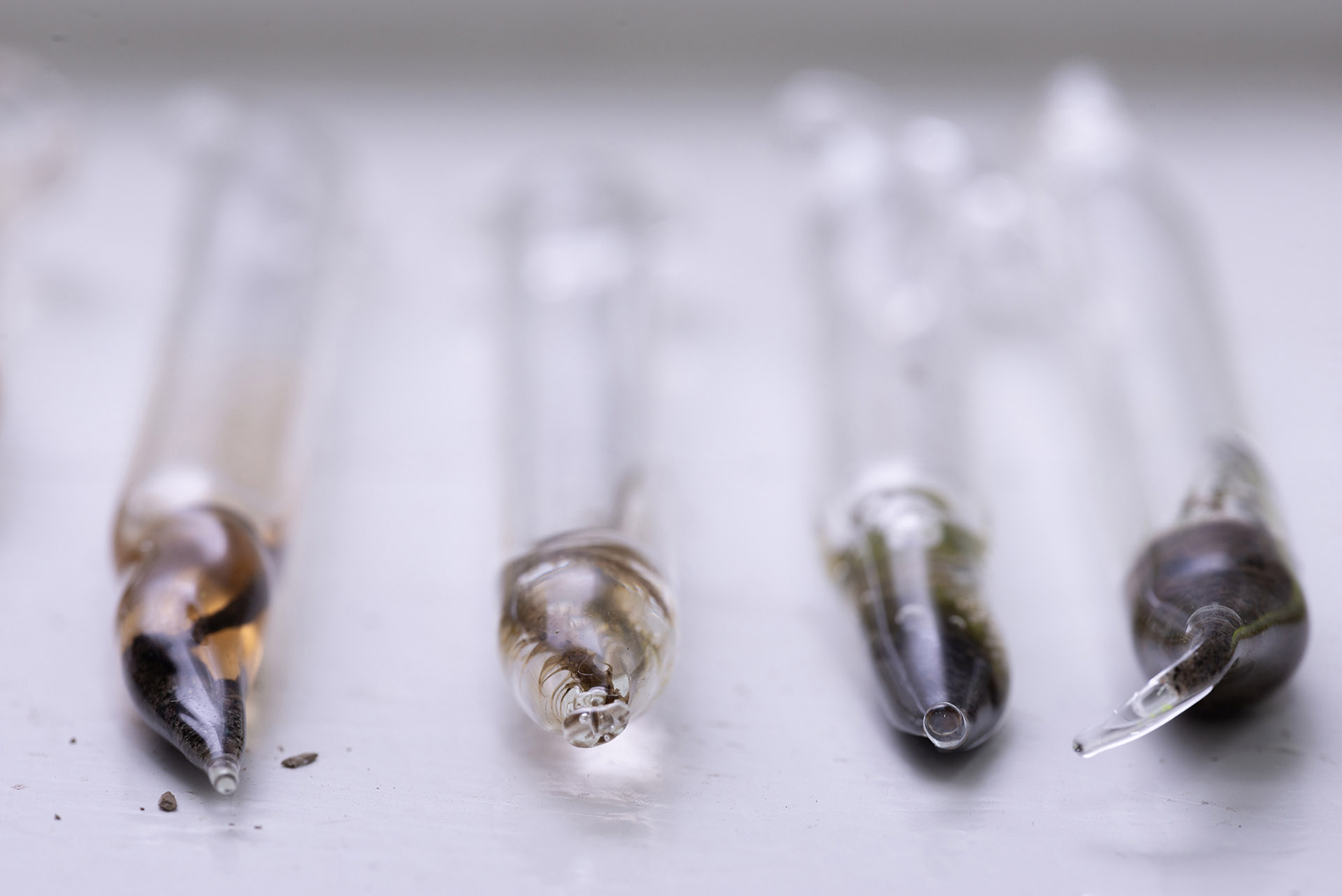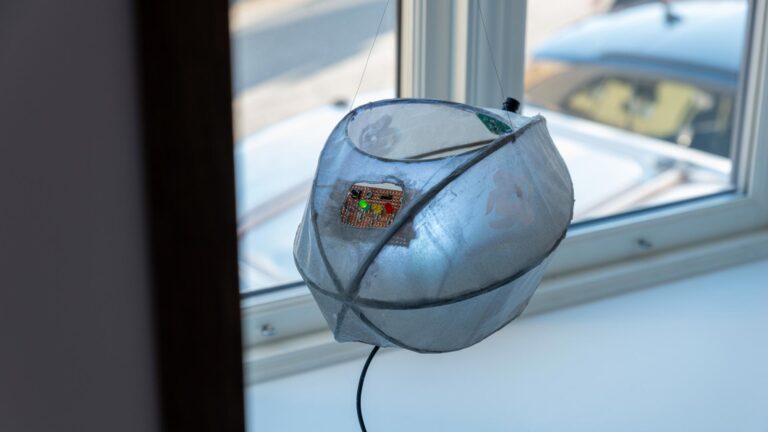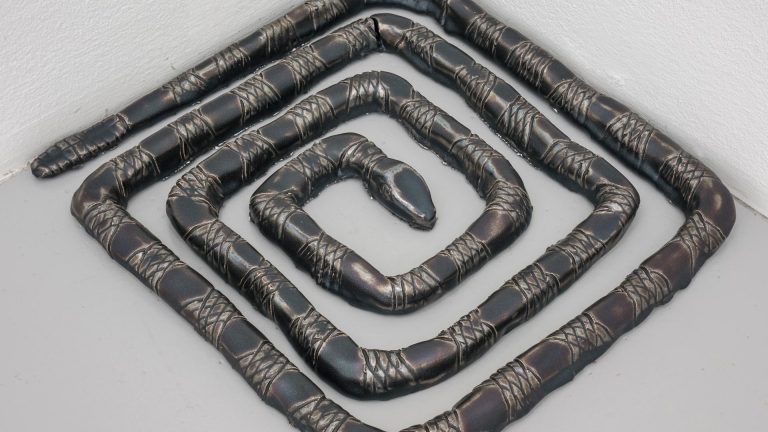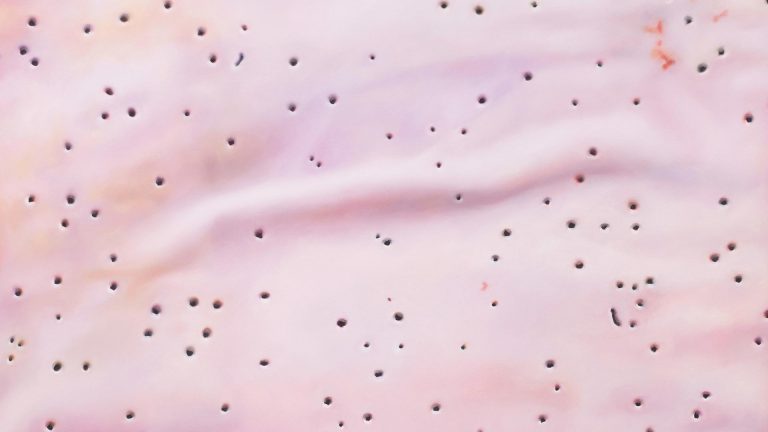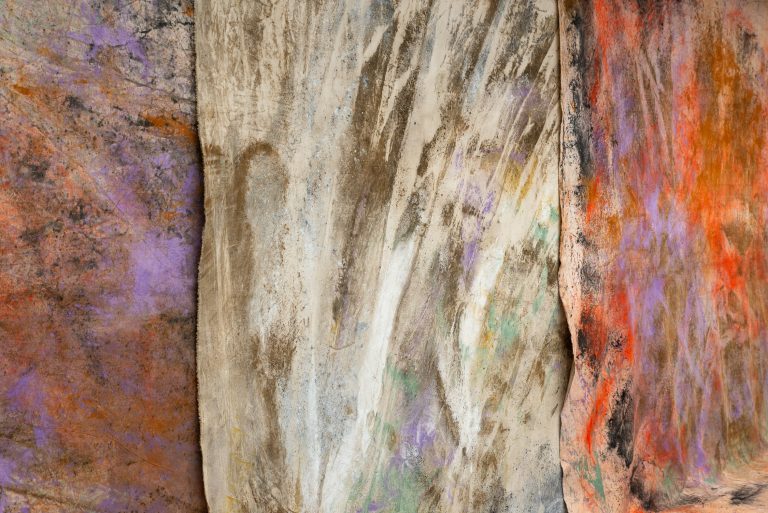Artist: Kåre Aleksander Grundvåg
Exhibition title: Earthworks
Venue: Entrée, Bergen, Norway
Date: October 9 – November 7, 2021
Photography: Bjarte Bjørkum / all images copyright and courtesy of the artist and Entrée, Bergen
Kåre Aleksander Grundvåg’s exhibition Grunnarbeid (Earthworks) comprises a series of sculptures 3D-printed in earth and clay. The sculptures are unique biotopes allowing local species of vegetation, moss, and algae to grow on them; over the course of the exhibition, the sculptures are in turn transformed through what grows in these biotopes. For the exhibition, Grundvåg has constructed a mechanical human-machine hybrid: combining parts from 3D-printer technology with the human body, he creates sculptural manifestations of how a local biotope and flora change in an antagonistic, yet symbiotic, relationship to human activity. Grunnarbeid is an ongoing project in which soil from multiple places are processed and mixed, and where soil from all previous versions will come together in future iterations.
The title Grunnarbeid (Earthworks) alludes to a central aspect of human activity: the redistribution of soil in order to facilitate development of societies and culture – architecture, infrastructure, agriculture, and extraction of natural resources. Common to these activities is their capacity to alter ecosystems – the original interplay between animals, plants, insects, and microorganisms. Some species are displaced, others adapt – and new species are introduced.
The materials Grundvåg uses are collected from landscapes that have been shaped over time by extensive human activity, and where the soil has recently been exposed, by humans or by natural forces. Soil and clay samples are processed and mixed in the gallery, where they form the composite material used in the printing process.
The sculptures at Entrée are made from a mixture of soil and clay from sites in Tromsø and Bergen where historical events and processes have occurred. The soil from Tromsø was collected at Nedre Håpet, where the first edition of Grunnarbeid was displayed in the open in 2020. Nedre Håpet is a small patch of land locked between residential buildings, untouched nature, and industrial facilities. Between 1970 and 2000, the area was populated by a temporary residential housing project for the disadvantaged. Today the houses are gone, their inhabitants spread across the city. Nothing remains but remnants of infrastructure: a stretch of road, a streetlamp and drainage pipes fighting trees and weeds rapidly taking dominion, helped by the original earthworks – planning, draining, the exposure of old layers of soil, planting and fertilising.
In Bergen, Grundvåg has collected soil from three sites. The former royal residence Alrekstad today borders the construction site of the new Bergen Light Rail track, cutting through the historical area. The soil was collected as close to the construction site as possible, in the zone between residential buildings and the excavation site. The other site is on Mount Fløyen – more precisely, collected from the exposed soil underneath the roots of a fallen tree found on a hill with Muledammen to the east and Breistølen to the west. The third soil sample was collected in the rubble after the flood when the Munkebotsvatnet dam broke in 2018.
While the soil in Tromsø and at Alrekstad have been developing since the last ice age, at least, the topsoil of Bergen’s Seven Mountains is young. Prior to 1868, the mountains were almost all bare rock, fell and pasture, a landscape almost devoid of trees. The Bergens Skog- og Træplantningsselskap (Bergen Tree and Forest Planting Society) was founded in 1868 to bring to Bergen continental ideas of a cultivated landscape as a dressed, rather than naked, landscape. The planting of trees was more than a beautification project; the central aspect was the development of a modern cultural identity where wild, uncivilised nature is brought to heel in the image of Man’s superiority over Nature. Grundvåg’s sculptures present a different picture. In this picture, nature and culture continuously mirror eachother. We exploit and shape nature with cultural, political, and economic goals, while nature adapts, finding new ways to express itself – and whether we like it or not, starts to speak a language we can understand and are unable to ignore.
Kåre Aleksander Grundvåg (b.1984) is a visual artist based in Tromsø. The coastal landscape of northern Norway is both his frame of reference and home. He holds a BA and Ma degree from the Academy of Fine Arts in Tromsø (2015). He is currently exploring non-human architecture through sculptural interventions in public spaces. Material knowledge, biomimetics and self-reliance are important elements in his work and thinking. Together with visual artist Trond Ansten, he formed the artist duo Devil´s Apron, which investigated the use of seaweed and marine resources through social and ecological experimentation. With a focus on combining traditional knowledge and new research. His work has recently been shown at Format Oslo (2021), Bergen Kunsthall (2021), Kunsthalle Wien (2021), Nordnorsk Kunstmuseum (2021), Kurant Tromsø (2020), The Autumn Exhibition Oslo (2019), LIAF Svolvær (2019), Barents Spectacle Kirkenes (2019), Meat the Future A.K.T Pforzheim (2019), and Arctic Arts Festival Harstad (2018).
Arne Skaug Olsen (b. 1974) is an artist, curator and writer. He holds an MFA in photography and an MA in Curatorial Practice from Bergen National Academy of Arts. Skaug Olsen has worked within higher art education for a number of years, and his last position as Associate Professor at Tromsø Art Academy, and currently at Faculty of Art, Music and Design, The Art Academy, University of Bergen. His ongoing project Fermenting Subjects, a collaboration with artist Anders Dahl Monsen, attempts to give microorganisms a voice and political agency. Fermenting Subjects’ next iteration will be at ALDEA in Bergen, and at Anchorage Art Museum, both in 2022. He also curated the Lofoten International Art Festival in 2015. He has also published art reviews for online journal Kunstkritikk since 2011, and he co-founded the art publishing project Ctrl+Z with Anne Szefer Karlsen in 2004. As an artist, he has participated in Biennale du Benin (2016) and Bergen Assembly (2012) and he was one of the artists at the Arctic Arts Festival, Harstad in 2018.
Kåre Aleksander Grundvåg Grunnarbeid, Earthworks. Installation view. All photos by Bjarte Bjørkum
Kåre Aleksander Grundvåg Grunnarbeid, Earthworks. Installation view. All photos by Bjarte Bjørkum
Kåre Aleksander Grundvåg Grunnarbeid, Earthworks. Installation view. All photos by Bjarte Bjørkum
Kåre Aleksander Grundvåg Grunnarbeid, Earthworks. Installation view. All photos by Bjarte Bjørkum
Kåre Aleksander Grundvåg Grunnarbeid, Earthworks. Installation view. All photos by Bjarte Bjørkum
Kåre Aleksander Grundvåg Grunnarbeid, Earthworks. Installation view. All photos by Bjarte Bjørkum
Kåre Aleksander Grundvåg Grunnarbeid, Earthworks. Installation view. All photos by Bjarte Bjørkum
Kåre Aleksander Grundvåg Grunnarbeid, Earthworks. Installation view. All photos by Bjarte Bjørkum
Kåre Aleksander Grundvåg Grunnarbeid, Earthworks. Installation view. All photos by Bjarte Bjørkum
Kåre Aleksander Grundvåg Grunnarbeid, Earthworks. Installation view. All photos by Bjarte Bjørkum
Kåre Aleksander Grundvåg Grunnarbeid, Earthworks. Installation view. All photos by Bjarte Bjørkum
Kåre Aleksander Grundvåg Grunnarbeid, Earthworks. Installation view. All photos by Bjarte Bjørkum
Kåre Aleksander Grundvåg Grunnarbeid, Earthworks. Installation view. All photos by Bjarte Bjørkum
Kåre Aleksander Grundvåg Grunnarbeid, Earthworks. Installation view. All photos by Bjarte Bjørkum
Kåre Aleksander Grundvåg Grunnarbeid, Earthworks. Installation view. All photos by Bjarte Bjørkum
Kåre Aleksander Grundvåg Grunnarbeid, Earthworks. Installation view. All photos by Bjarte Bjørkum
Kåre Aleksander Grundvåg Grunnarbeid, Earthworks. Installation view. All photos by Bjarte Bjørkum
Kåre Aleksander Grundvåg Grunnarbeid, Earthworks. Installation view. All photos by Bjarte Bjørkum
Kåre Aleksander Grundvåg Grunnarbeid, Earthworks. Installation view. All photos by Bjarte Bjørkum
Kåre Aleksander Grundvåg Grunnarbeid, Earthworks. Installation view. All photos by Bjarte Bjørkum
The gallery is made into an ecosystem providing perfect conditions for the sculptures’ biotopes, allowing local species of vegetation, moss, and algae to grow on the sculptures through the course of the exhibition
The gallery is made into an ecosystem providing perfect conditions for the sculptures’ biotopes, allowing local species of vegetation, moss, and algae to grow on the sculptures through the course of the exhibition
Steam, alongside moisture from the gallery and its audiences, gets collected by a dehumidifier and is recycled back as water into connected humidifiers. The water then loops back as foggy mist
Steam, alongside moisture from the gallery and its audiences, gets collected by a dehumidifier and is recycled back as water into connected humidifiers. The water then loops back as foggy mist
Glass ampoules containing unique and balanced terrarium ecosystems combining material from several locations in Tromsø and Bergen linked to places of human history and activity
Glass ampoules containing unique and balanced terrarium ecosystems combining material from several locations in Tromsø and Bergen linked to places of human history and activity
Glass ampoules containing unique and balanced terrarium ecosystems combining material from several locations in Tromsø and Bergen linked to places of human history and activity
Glass ampoules containing unique and balanced terrarium ecosystems combining material from several locations in Tromsø and Bergen linked to places of human history and activity
Glass ampoules containing unique and balanced terrarium ecosystems combining material from several locations in Tromsø and Bergen linked to places of human history and activity
The raw sculptures are being fired in the kiln after the exhibition period and returned to the same locations in nature with a potential of becoming homes for other species or perhaps archaeological curiosities of a distant future
The raw sculptures are being fired in the kiln after the exhibition period and returned to the same locations in nature with a potential of becoming homes for other species or perhaps archaeological curiosities of a distant future


























